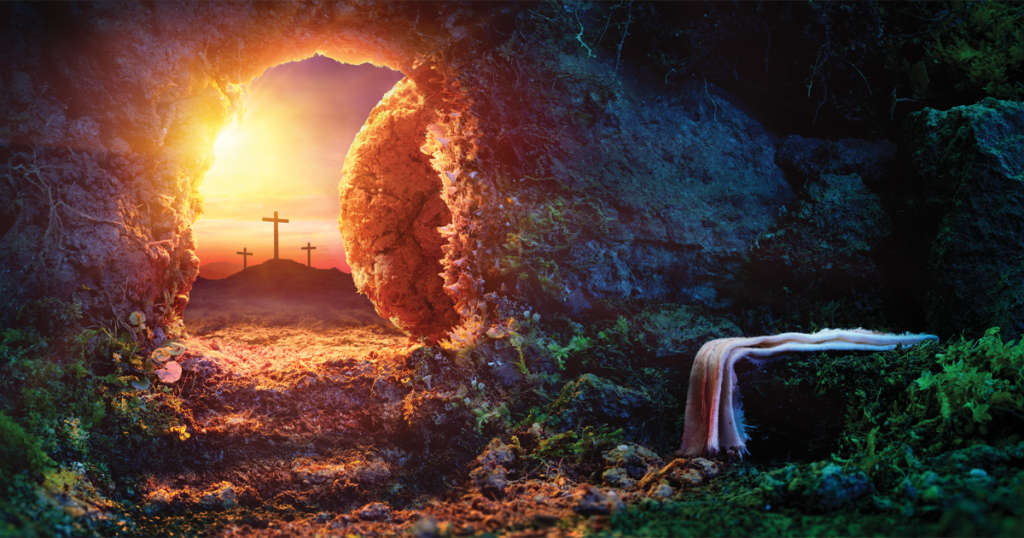Easter People
"Disciples need to gather with other disciples, so that the living Christ can teach them as a Body how to relate to him, each other, and their neighbors."
The resurrection of Jesus that took place almost two thousand years ago was more than an event in the distant past. He was let loose in the world and is still at large around this globe, in your city, your community, your church, and in you. He is risen! And the question that begs an answer from you and me is: Are we going to believe it, receive it, be changed by it—and live accordingly?
Matthew says, “… an angel from the Lord came down from heaven. Coming to the stone he rolled it away and sat on it” (Matthew 28:2). The stone wasn’t rolled away to let the Lord out; it was rolled away to let us in. Yes, you and me—let in to have to come to terms with the very real presence of the living Lord and the very real power of the love he wants to release in our lives.
The sight of an empty tomb is hard for the two Marys to take in. The angel says to the women, “Don’t be afraid. You’ve been grieving over a dead Jesus. Now you need to encounter a living Jesus, a Jesus who will never leave you nor forsake you and will change your life completely if you let him.” They run back to tell the disciples. But they still can’t get their minds around it.
And then it happens. The resurrection becomes a reality for them. “Greetings,” says Jesus. They timidly approach him. They fall down before him and take hold of his feet. And they worship him.
Suddenly the resurrection of Jesus is no longer information passed along by some angel. It is a life-changing encounter. It is reality in person. Jesus is risen!
One-on-one encounters with the risen Christ happen in different ways and for different reasons. Mary is grieving first over Jesus’ cruel death and now the removal of his body, preventing her from anointing it as her last gift of love. Suddenly, she encounters a living Jesus. It changes everything. Her Lord is not imprisoned in the past; he is freely her Lord in the present and future. The risen Christ looks into the eyes of a Peter mired in the guilt of his shameful denial and asks only for Peter’s confession of love. Repentant Peter responds three times, “Yes, Lord, you know I love you.” And Jesus’ forgiveness is surprisingly proven in the form of a commission for Peter to pastor Christ’s flock of followers. Thomas feels left out and forgotten and begs for evidence of his fellow disciples’ encounter with a risen Christ. He needs to see his Lord in person, he needs to see the identifying marks of crucifixion, and he also needs the blessing of peace and the Holy Spirit’s power. Jesus appears again, goes to Thomas, invites him to touch the marks of his crucifixion love, and says, “Believe!” Thomas is now able to say, “My Lord and my God!” And Jesus then pays tribute to all those who are not able to see him in person but still believe. Saul is a well-educated religious fanatic using the authority the temple leaders have bestowed on him to snuff out this new movement of Jesus’ followers. On the way to Damascus to continue his work of making martyrs of Christians, he is blinded by “a light from heaven” and falls to the ground. He doesn’t see the resurrected Jesus, but he hears his voice: “Saul, Saul, why are you harassing me?” There and then, the whole course of his life changes.
I think these one-on-one encounters with our resurrected Lord were put in Scripture for a reason. They are invitations to each of us. Perhaps you can identify with Mary because you are in grief. Or with Peter because you feel you laid low when our Lord needed you to speak or act. Or with Thomas because you feel left out or are too captive to your doubts. I can personally identify with all of these situations.
The New Testament uses words that are best translated as “appear” or “appearance” to describe the visual encounters with the resurrected Jesus by disciples who knew him in the flesh, as well as to describe the final “appearance” of Jesus when his kingdom comes in its fullness. In between, Scripture tends much more to speak of encounters with the living Christ as “revelations.” An appearing of Jesus emphasizes the assurance given by sight; a revelation of Jesus suggests something that penetrates us, whether it is seen or unseen. A revelation of Jesus is an uncovering, an honest disclosure that exposes us to ourselves and, in doing so, nudges us toward keeping our gaze on Jesus.
Our encounter with the living Christ is never a private affair, just as loving God can never be separated from loving others (1 John 4:20). Those who accept the call to be reconciled to God through Christ are at the same time called to participate in the new reconciled Body of Christ and become themselves agents of reconciliation (2 Corinthians 5:16-20). Disciples need to gather with other disciples, so that the living Christ can teach them as a Body how to relate to him, each other, and their neighbors.
Photo courtesy of Getty
Dear Lord, you have called us to be together, to gather as your people and to be formed as your disciples. I need so much to meet you in the gatherings and to experience you in the presence of others. Please teach me how to be a brother or a sister who opens myself to others and to the world. I ask this in the name of our risen and ever-present Lord Jesus. Amen.







